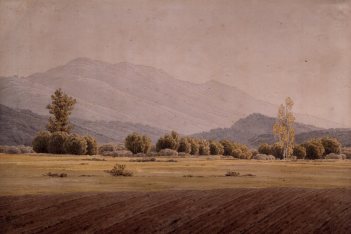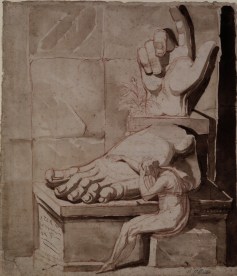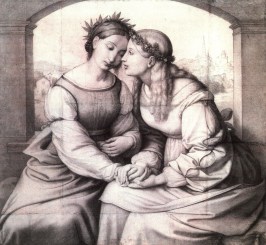
The golden age of german romanticism
Mr. Daniel Marchesseau, director of the Musée de la Vie Romantique in Paris and co-commissionner of this exhibition, leads us through the period of German Romanticism and its main protagonists.
You can discover here a hundred and twenty-four exceptional drawings and watercolours by some sixty artists.
_ An anthology of drawings testifies to the abundant creativity of this period so rich intellectually.
The works presented here seem very confidential and limited in time and « genre », and nonetheless they open a whole universe. As though through a magnifying glass, one gets to peer into the soul of this period with its metaphysical outbursts and concrete life.
The « age of Goethe » was a rather troubled one :
Goethe lived through the Enlightenment, constitutional monarchy, the French revolution, the Napoleonic occupation and the wars of liberation, then the Restoration, and the Sturm und Drang, Romanticism and Biedermeier -art bourgeois- times. Quite an important and varied historical period!

- Did the artists represented in this exhibition, have a direct or particular relationship with these historical currents ?
- Is it possible to present a synthesis or a definition of this exceedingly generalised notion of « German romanticism » ?
- What were the relationships and exchanges between France and Germany in Goethe’s days ?
All these issues and more are developed by Daniel Marchesseau.
After this overview of the Goethe period, we’ll walk through the various exhibition rooms of « The Golden Age of German Romanticism ».
- As at this period – between the end of the XVIIth and the beginning of the XVIIIth century –, drawing was the main and most distinguished form of artistic expression in the field of the Fine Arts, we’ll discover the main artists of this selection here.
- Several emblematic figures deserve special mention:
C.D. Friedrich, P.O. Runge, J.H. Füssli, J.H. Tischbein ou J.G. von Dillis, Moritz von Schwind, Karl Friedrich Schinkel, L. Richter, and Nazarenes like F. Overbeck or J. Schnorr von Carolsfeld, etc. What a gathering!

In the first room, we find a drawing by Goethe, a Veduta of Rome.
(He stayed in Rome, Naples and Sicily for a few months, the « happiest period of his life». He started drawing with J.H. Tischbein and J.P. Hackert, met young Angelika Kauffmann and raved about Antiquity and Winckelmann’s theories.
Further to be seen are works by J.G. Shadow, A. Kauffmann (A Tribute to Goethe, she drew Goethe’s bust). J.H. Tishbein (Reynard the Fox, based on Goethe’s political satire, The Battle of Leipzig).
Then there is the Academic tradition, with drawings by Hackert (Vedute of Rome, internationally appreciated) , J.G. Wille (Rat poison),
D. Chodowiecki (The Senator and collector J.V. Myer’s family, hommage in the manner of Rousseau).
Another room dedicated to Italy : «The happiness of unlimited and unconstrained independence » ( J.C. Reinhart)
Reinhart (with The Fight against storm, he was following Schiller’s ideas on the freedom of mind indifferent to the outside violence).
At those times, the young artists of Europe felt obliged to make their « Italian Tour» , a journey of initiation. During their years of apprenticeship, they gathered in Rome on the Roman Forum or on the banks of the Tiber…
Pre-romanticism – Sturm und Drang (Storm and stress), circa 1770-1790.
At the time of feudality and absolutism in Germanic states of all sizes, writers and philosophers like Schiller and Goethe expressed a new attitude. Their new feeling for nature strongly dominated by emotion was influenced by the writings of J.J. Rousseau. Artists followed and raved about traditional songs. Germanic poetry (Herder), ancient tales (the Grimm Brothers) and Gothic art which became symbolic of Germanic art.
We find here a quite well-known artist, the Swiss J.H. Füssli who later settled in England. He found inspiration in Homer, Dante, Milton, Shakespeare and the Nibelungenlied. In Rome in 1770, the colossal statue of the Emperor Constantine and Michel Angelo’s frescoes fascinated him. He is considered as a chief exponent of Sturm und Drang.

The Romanticism of the North
The main representatives of the Germanic protestant regions of the North were Philip Otto Runge (1777-1810) (like Goethe, he wrote a Theory on Colours and sent him his Self-portrait, Evening/Morning ).
And Caspar David Friedrich…
«The painter shouldn’t only paint what he sees before him, but also what he feels within», C.D. Friedrich’s Aphorisms.
If the night itself should rise, if a nocturnal day and a diurnal night could embrace us all, it would be at last the ultimate goal of all desires. (Friedrich).
J.G. Schadow (a remarkable sketch of Friedrich Schiller, The sleeping Love, an elegiac drawing dominated by the contrast of shadow and light).
Moritz von Schwind (1804-1871), (a close friend of Schubert’s, His work, Death and the Maiden, was inspired by the composer’s Lied. His Apparition in the forest, which belongs to the realm of German fairy tales ; a very fine leaf, inspired by Dürer’s engravings, largely commented by Daniel Marchesseau.
K.F. Schinkel is represented among others by a superb drawing, Sailing on the Königsee, one of Daniel Marchesseau’s favourites. He evokes it with deep enthousiasm.

And then a collective movement from the Southern catholic regions, the Nazarenes.
J. von Fürich met the Nazarenes in Rome. He had arrived in the city in 1810. His Self-portrait shows Raphael’s strong influence on the Nazarenes’ model.
J. Riepenhausen (1788-1860) (Raphaël paints la Fornarina), 1829. Riepenhausen visited Ingres who was painting the same subject in Rome. Riepenhausen emphasised the spiritual dimension.
J.F. Overbeck (1789-1869), (the leader of the Nazarene group. He remained an admirer of Raphaël and stayed in Rome all his life. A characteristic opus of Nazarenes art, his Italia et Germania, shows a dark haired Italia in Raphaël’s style with an Italian landscape , a blond Germania in the style of Dürer with a German city in the background… Other Overbeck drawings in this selection : Entombment, 1814, a superb work inspired by Raphaël’s « Christ being laid in the tomb » (1507), Madonna on a stone bench : the image of the Holy Virgin of the Quattrocento art inspired him deeply, Tancrede and Clorinda, a study for a fresco of « Jerusalem Delivered » by Torquato Tasso.

- Other currents are also present, including Naturalism and the Munich School of landscape painting.
Thanks to Daniel Marchesseau, we can immerse ourselves in Goethe’s period of German Romanticism and in these very delicate drawings and watercolours.
These works are a perfect illustration of the capacity of the romantics to seize the ephemeral character – both in technique and in ‘genre’ - , the fleeting instant that nonetheless remains to the present day, which expresses a strong and deeply moving fragility.
A Superbe Catalogue of the exhibition was published by Paris Musees under the direction of Hinrich Sieveking.
With contributions by Daniel Marchesseau and Pierre Rosenberg of the Académie Française .
An art book in which every single drawing or watercolour presented in this exhibition is reproduced full page with remarkable quality and an analysis also full page by the most distinguished art historians of German Romanticism.
Learn more :
At this point it is only available in French at the Musée de la Vie Romantique, 16 rue Chaptal 75009 Paris.
The exhibition can be seen until the 15th of June 2008 at the Musée de la Vie Romantique, the most romantic site in the heart of the city next to the famous quarter of Montmartre. A nineteen-century residence of the painter Ary Scheffer (1795-1858) composed of several italian-style pavillions surrounded by a delightful garden of roses and lilacs.
The exhibition has received the support of the Rudolf-August Oetker Foundation for Art, Bielefeld et de Madame Maja Oetker
Links :
L’âge d’or du romantisme allemand
Das goldene Zeitalter der deutschen Zeichenkunst
Sous le regard de Goethe, commenté par Pierre Rosenberg